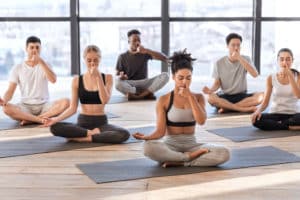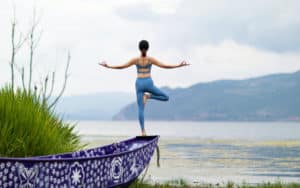
INTRO
What is Yoga?

Yoga is a physical, mental, and spiritual discipline that originated in ancient India. It involves a variety of physical postures (asanas), breathing techniques (pranayama), and meditation practices. Yoga is designed to improve flexibility, strength, and balance, as well as to promote relaxation and reduce stress.
There are many different styles of yoga, each with its own unique focus and approach. Yoga can be practiced by people of all ages and fitness levels, and can be modified to suit individual needs and abilities.
Starting a yoga challenge with a friend is a great way to involve someone who might like to build a yoga habit with you, while keeping you motivated and on track!
Health Benefits of Yoga
There are many potential health benefits associated with the practice of yoga. Some of the benefits that have been demonstrated through scientific research include:
Improved balance & flexibility
Yoga can help improve balance, flexibility and range of motion in the joints. Many of the postures in yoga require holding the body in new positions, which activate different muscles responsible for balance and coordination.
Increased strength & weight management
Strength, especially in the core, upper body, and lower body, can also be improved through yoga practice.
Reduced stress & better sleep
Yoga has been shown to reduce stress, anxiety, and depression by promoting relaxation and mindfulness, which can help to improve sleep quality and quantity.
Weight management
Practicing yoga can help with weight management by promoting healthy habits and increasing physical activity.
Pain management
Yoga may be helpful in managing pain, including chronic pain conditions.
Common Yoga Poses

There are many different actions, or asanas, that are performed in yoga. Some common actions include:
Standing poses: These poses involve standing on one foot or both feet and may include mountain pose, warrior pose, and tree pose.
Seated poses: These poses involve sitting on the floor and may include easy pose, hero pose, and bound angle pose.
Twisting poses: These poses involve twisting the torso and may include seated twist, revolved triangle pose, and revolved half moon pose.
Backbends: These poses involve arching the back and may include cobra pose, upward facing dog pose, and camel pose.
Inversions: These poses involve inverting the body and may include headstand, shoulder stand, and handstand.
Forward folds: These poses involve folding the body forward and may include seated forward bend, standing forward bend, and downward facing dog.
Restorative poses: These poses involve relaxing the body and may include corpse pose, legs up the wall pose, and supported fish pose.
These are just a few examples of the many actions that can be performed in yoga. Take the time to find which ones work for you!
Different Yoga Styles
There are many different yoga styles, each with its own unique characteristics and focus. Take some time throughout your yoga challenge to explore the different styles to find one that works for you.
Hatha yoga
Hatha yoga is a general term that refers to any type of yoga that involves physical postures, or asanas. Hatha yoga is a good option for beginners because it is generally slower-paced and less strenuous than other styles of yoga.
Vinyasa yoga
Vinyasa yoga, also known as flow yoga, is a style of yoga in which movement is synchronized to the breath. Vinyasa classes often involve flowing through a sequence of poses and may be more physically demanding than Hatha yoga.
Ashtanga yoga
Ashtanga yoga is a style of yoga that involves performing a set series of poses in a specific order. Ashtanga classes are typically more physically demanding and may not be suitable for beginners.
Bikram yoga
Bikram yoga, also known as hot yoga, is a style of yoga that is performed in a heated room. Bikram classes typically involve performing a series of 26 poses in a specific order and are known for being physically demanding.
Yin yoga
Yin yoga is a style of yoga that involves holding poses for extended periods of time, typically 3-5 minutes. Yin yoga is a more passive, relaxing practice that is focused on stretching the connective tissues of the body.
Iyengar yoga
Iyengar yoga is a style of yoga that emphasizes precise alignment and the use of props, such as blocks and straps, to assist in performing the poses. Iyengar classes may be more suitable for students who are looking for a slower-paced, more focused practice.
How to Start a Yoga Practice
1
Find a class or instructor that is right for you
There are many different styles of yoga, and it’s important to find one that is right for you. Consider your fitness level, any physical limitations you may have, and your goals for practicing yoga. It can also be helpful to find an instructor who is knowledgeable and can provide guidance and support.
2
Start slow
It’s important to ease into your yoga practice and not try to do too much too soon. Start with short, beginner-level classes and gradually increase the length and intensity as you become more comfortable with the practice.
3
Practice consistently
The key to developing a habit is to practice consistently. Try to set aside a specific time each day or week for your yoga practice, and stick to it as much as possible. Even if you can only fit in a short practice, it can be helpful to establish a consistent routine.
4
Be patient
Developing a yoga practice can take time, and it’s important to be patient and not get discouraged if you don’t see progress right away. It can also be helpful to set realistic goals for yourself and celebrate your progress as you go.
5
Don't compare yourself to others
It’s natural to want to compare yourself to others when starting a new activity, but it’s important to remember that everyone is different and progresses at their own pace. Focus on your own practice and don’t worry about what others are doing.
6
Make it enjoyable
The most important thing is to make your yoga practice enjoyable and something that you look forward to. Find ways to make it fun and incorporate it into your daily routine in a way that works for you.
Overcoming Common Yoga Setbacks

There are many potential setbacks that can arise when trying to practice yoga regularly, but there are also ways to overcome these challenges. Here are some tips for overcoming common setbacks:
Lack of time: One of the most common challenges is finding time to practice. If you’re struggling to fit yoga into your schedule, try to prioritize your practice and make time for it.
You might also try finding shorter practices that can be done in a limited amount of time, or practicing yoga at home using a video or online class.
Lack of motivation: It can be difficult to stay motivated when practicing yoga regularly, especially if you’re not seeing progress as quickly as you’d like. To overcome this challenge, try setting achievable goals for yourself and celebrate your progress as you go.
Physical limitations: If you have physical limitations that make certain yoga poses difficult or impossible, it’s important to listen to your body and not push yourself too hard.
It can be helpful to modify poses as needed or try different styles of yoga that may be more suitable for your needs. It’s also important to consult with a healthcare provider or a qualified yoga instructor if you have any concerns.
Lack of support: It can be helpful to have the support of others when trying to establish a regular yoga practice.
If you’re struggling to find support, consider inviting a buddy to join you in your yoga challenge or joining a class to help keep you motivated. Or, consider reaching out to a yoga instructor or therapist for guidance and support.
Fear of failure: It’s natural to feel nervous or uncertain when starting something new, but it’s important to remember that everyone has to start somewhere. Try to focus on your own progress and not worry about what others are doing.
It can also be helpful to remind yourself that there is no “right” or “wrong” way to practice yoga and that the most important thing is to find what works for you.
Common Yoga Questions
If you are already flexible, yoga may still be beneficial for you in other ways. Yoga can help improve balance, strength, and focus, as well as reduce stress and tension in the body. Additionally, the practice of yoga can help you to become more mindful and present in the moment, and can be a beneficial form of self-care.
It’s important to find a yoga class that fits your needs and interests, and to communicate with the instructor about your level of flexibility. They can provide modifications and variations that challenge you in new ways and help you to continue to progress and strengthen your muscles.
Also, you could consider different styles of yoga that may be more challenging for you. For example, vinyasa yoga, power yoga, and ashtanga yoga are some styles that could be more dynamic and physically challenging.
Yes, you can still practice yoga even if you are not flexible. Yoga is not about being flexible, it’s about creating balance and strength in the body. Yoga is a practice that can help increase flexibility over time, but it is not a requirement to start.
Yoga can be modified to suit your current level of flexibility and the teacher can guide you to adjust the poses accordingly. It’s important to listen to your body and not push yourself too hard, as this can lead to injury.
Hatha yoga is typically recommended for beginners as it is a slower-paced style that focuses on proper alignment and breathing technique. This style of yoga is also great for building strength and flexibility, and can help reduce stress and promote relaxation.
Other styles that are good for beginners include Iyengar and Vinyasa yoga. It’s important to find a class that is taught by a qualified instructor who can guide you through the proper form and alignment for each pose.
When practicing yoga, it’s best to wear comfortable, breathable clothing that allows for a full range of movement. Avoid clothing that is too tight or restrictive. Clothing made from natural fibers such as cotton or bamboo is ideal.
It’s also important to consider the type of yoga you’ll be practicing, as some styles may require more coverage than others. During hot yoga, you may want to wear lightweight, moisture-wicking clothing to keep cool and prevent chafing.
Support Your Yoga Practice
If you’re struggling to keep up with your yoga challenge, we suggest exploring some different yoga support options.
Join a class: One of the best ways to create a habit of practicing yoga is to join a class. Attending a class can provide you with a sense of accountability and structure, and it can be a great way to meet other people who are interested in yoga.
Practice at home: If you prefer to practice yoga at home, there are many resources available, such as videos, online classes, and books, that can help guide you through a practice.
Use a tracking app: Tracking apps can be a helpful tool for establishing a habit of practicing yoga. These apps allow you to log your practice and set reminders to help you stay on track.
Find a yoga buddy: Practicing yoga with a friend can be a great way to stay motivated and accountable. Consider finding a friend or family member who is also interested in yoga and try a yoga challenge together.
Hire a private instructor: If you’re having trouble establishing a regular practice, you might consider hiring a private instructor. A private instructor can provide you with personalized guidance and support, and can help you develop a practice that is tailored to your needs and goals.
Seek the support of a therapist or coach: If you’re struggling with a specific issue, such as stress or anxiety, it may be helpful to seek the support of a therapist or coach who is trained in incorporating yoga into their practice. A therapist or coach can help you develop strategies for incorporating yoga into your daily routine and can provide you with ongoing support and guidance.










